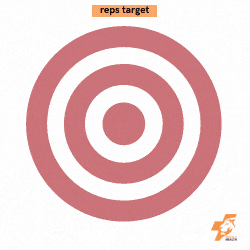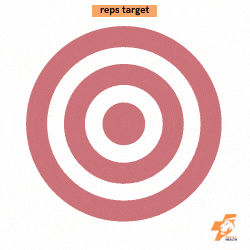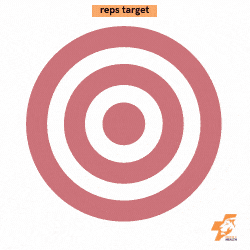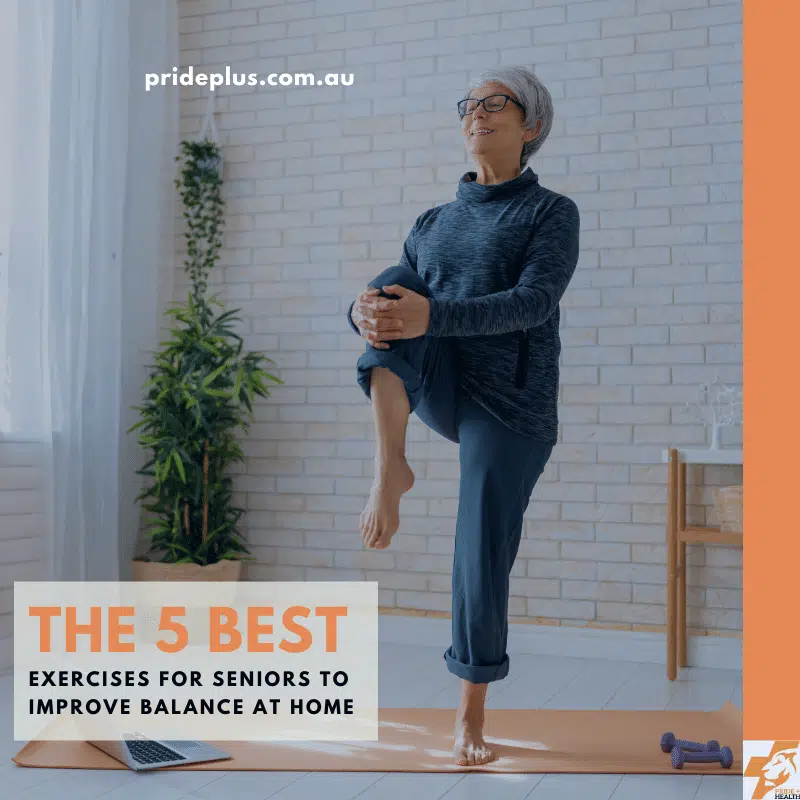Looking to get some more energy and swerve in your step as you get a few more birthdays under your belt? Here’s my 5 best seniors exercises at home here to get you started.
As an exercise physiologist I’ve had the pleasure of working with some of the fittest, bravest and most interesting athletes who proudly call themselves seniors. Actually, it’s one of the more rewarding parts of my work week hearing just how easy every day life is for our seniors who have a strong relationship with exercise.
But it doesn’t always start that way.
There’s often barriers to break through before we get to the fist-pumping, high-fiving, easy living that comes with fitness in our older years. Not everyone has the opportunity to see an exercise professional for individual sessions or small group exercise classes. So, here I’m bringing you my 5 best seniors exercises at home with a special focus on balance. Upper body exercises are also vitally important which I’ll bring you in another work out.
Get your personalised training program from your EP by booking in your session today.
Appointments available in clinic for one on one sessions and small group classes.
Seniors Exercises at Home
To complete these exercises you’ll need to find a sturdy chair. With these balance exercises we’re not going to add any extra weight. For when we do come to an exercise program which includes upper body work outs you can use dumbbells or a water bottle in each hand. I’ll also explain a couple of exercise principles.
Sets & Reps
Generally you will complete 2-3 sets of each given exercise. When it comes to repetitions there is no magic number. You can test yourself out and find the number of repetitions at which you fatigue. Fatiguing feels like tiredness and tightness in the muscles you’re working. For your purposes, you don’t need to push past this point. You will find that the point at which you fatigue will gradually become longer and longer – this is how you know you’re improving!
I’ve added a repetition target for each exercise that is very generalised but will give you something to work towards.
Rest Period
Don’t forget to use rest periods! So very often we don’t give ourselves enough rest between our sets of strength exercises. Rest periods give your muscles and nervous system time to recover to do it all again with the same quality. Aim to give yourself about 30-45sec of rest in between sets to keep that quality of movement high.
To build muscle mass and muscle strength you need to have adequate rest periods between exercise days as well. Develop an exercise regimen that gives your body recover time by completing a balance exercise program like this one day, and upper body exercises the following.
Chair Squats
Chair squats are great for working the big muscles in your legs that help you walk, get up from sitting down and keep you steady on your feet.
Start by sitting in a sturdy chair, adjust your feet to be in line with your hips and position your feet flat underneath your knees. Move toward the edge of your chair. This is your starting position. Slightly lean forward, push through your heels and stand up. Slowly lower your bottom to the chair and sit down. Repeat.

15 repetitions of this exercise for seniors is an excellent score. Seniors who are able to build themselves to comfortably complete 15 repetitions of this exercise have been shown to significantly reduce their risk of falling and are categorised as having above average lower-limb strength and endurance.
Calf Raises (with a chair)
Calf raises and calf push-ups are two of the most important exercises for seniors. Your calf muscles are the star of the show when it comes to walking and keeping your ankles nice and steady. These are beneficial exercises for those who want to walk further and move safely around our house and the community.
Start with lining up your feet with your hips, have your toes facing forwards. In this position your feet shoulder width apart. Gently hold onto your chair, focus on pushing through your big toes as you raise your heels up off the ground slowly. I want you to focus on moving straight up and down, no forward and back movements. Rocking like this is cheating!
Once you’re up as high as you can go without losing the straightness of your foot or losing balance, lower your heels slowly all the way to the ground. Repeat this until you feel fatigue, without compromising the quality of your movement.

20 reps is the general goal. This exercise is harder than you think so start small and gradually build yourself up. We’re aiming for endurance so we need higher reps for this one, but don’t sacrifice quality for quantity – we want good, smooth reps!
Step Ups
Step ups can be tough exercises for seniors but they are so very good to practice attacking those steps you’ve been dreading at home or when you’re out and about. This exercise, like the squats, works the big muscles in your legs so you should be feeling it in your thighs.
The biggest tip for this one is this: whatever leg you choose to go up the step with, step down with that leg too. So if you go up with your right leg first, make sure that the you step down with the right leg first too. Make sure to give yourself plenty of room so you don’t clip your foot on the edge.

It can be easy to over-do it with this one so take it slow and build up gradually. If you get over 15 reps on both sides without much discomfort or fatigue you’re doing really well. You will have lowered your falls risk and built up excellent strength and endurance in your legs.
Hip Abduction
We all love a good glutes exercise. Your glutes are your muscles in the buttocks region. They are really important for keeping your hips steady, taking weight while you walk and keeping you on your feet as you stand. One of the big muscles back there helps to move your leg out to the side. This is called hip abduction and is demonstrated in the video above.
Start in a standing position, holding onto the chair. Stand up tall and keep your toes facing forwards. Slowly move your leg out to the side, keeping your toes facing forwards. Try not to rotate your hips or your foot or lean over – keep tall and straight. Repeat either side. You should feel this exercise in the side of your hips.

We need strength and endurance in the muscles you’re using here. Starting with endurance is a good place to start so aim for 15 or more. Once again, start with what is achievable and what you can do with quality. Strong and steady hips form part of your core strength and go a long way to help you keep balanced.
Hip Extension
Another exercise for your glutes. In this exercise you are moving your leg straight back behind you. This makes your glutes muscles work to bring your hips into hip extension. Hip extension is important for when you’re walking, standing still and while balancing on one leg.
Stand holding onto a chair or table, stand up tall and move one leg back behind you, finishing with your back leg straight and touching the ground with your toes, squeeze those glute muscles at the back of your hip in the end position. Repeat either side.

Endurance-focused again with this exercise to start with. Generally, this is a little easier than the hip abduction exercise so don’t be surprised if you find yourself pushing ahead with this one.
Seniors Exercises at Home – The Benefits of Regular Physical Activity
Exercise is good for us all but especially so when we are getting on in age. It helps keep bones healthy, muscles toned and joints flexible. Completing exercises at home regularly will help you improve or maintain a great quality of life. And if you’re like me then you know what happens when you stop exercising regularly… my muscles get stiff and sore, I lose muscle tone, strength and flexibility. My energy levels drop too and it can feel like too much hard work getting started again.
Not sure if you need a physiotherapist or an exercise physiologist? Take the quiz to find out.
FAQ About Seniors Exercise
Quick speed round here of questions I get asked regularly about seniors exercises at home and in the clinic.
Why do seniors need to exercise?
People at all ages should be engaging in exercise and physical activity to help them lead an active and healthy lifestyle. Exercise can help prevent a long list of chronic diseases and even help manage diseases like Type 2 Diabetes and Heart Disease.
Exercise is particularly important in seniors to reduce frailty, maintain mobility, manage health conditions and reduce the risk of falling.
What benefits will exercising have on your health?
The big benefit of exercise is simply to make your body more robust and capable of completing the everyday tasks you want to do.
Outside of muscle strength, there is so much evidence and research that outlines the benefits of exercise on other markers of physical health. Lowering blood pressure and regulating blood glucose levels, improving mental and emotional health, preventing chronic disease and managing chronic disease.
The list is so very long. Its summed up best in this quote:
“If exercise could be packaged in a pill, it would be the single most widely prescribed and beneficial medicine in the nation.”
Exercise isn’t a silver bullet for all your health problems but gee it has such a positive impact across so many aspects of your health.
Am I too old to lift weights?
Absolutely not! Lifting weights through resistance training is strongly recommended for older adults and seniors.
Some bodyweight exercises might feel too easy, you might be too strong – so lifting more load through using dumbbells, resistance bands or ankle and wrist weights would be recommended to increase your strength.
Lifting additional load triggers your body to make adaptations like growing more muscle, building new blood vessels or even just making the muscle you do have better at doing their job.
Can I exercise when I’m in pain?
Yes, you can. Exercising with some level of discomfort or pain is ok. However, it’s best that you seek the guidance you need from your exercise physiologist or physiotherapist.
It is important to remember that hurt does not equate to harm. Of course, if you have an injury or long-standing pain, we will look to avoid aggravating the sore spot and get it to calm down. There’s many different exercises and movements we can use to accommodate and make the exercise more tolerable. It does not matter if you have limited mobility to start, there’s always different types of exercises and exercise routines we can adapt to suit your needs.
Where can I see an exercise physiologist?
An Exercise physiologist is your exercise professional who can assess and prescribe you the best exercises for you. We’re able to adjust different exercises for seniors, for juniors and everyone in between.
Strength training, aerobic activity, simple exercises or complex programs are all able to be tailored to your needs.
To see our team you can book an appointment on your own or you can see your GP for a referral. If you have a chronic condition then you may be eligible for a short burst of medicare funding to help you access the training you need.
And for those with private health insurance, most fund exercise physiology in extras cover too.




